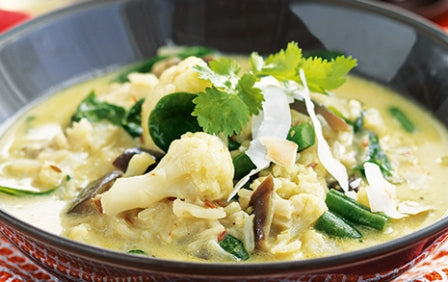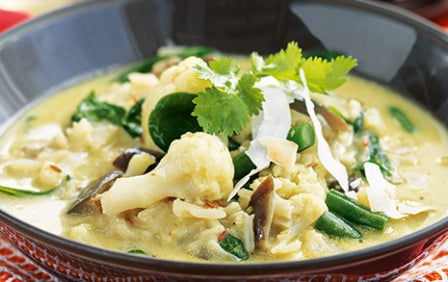Vegetable Curry
Vegetable Curry
Fragrant and tangy, this creamy curry-style dish is a great way to use up leftover vegetables or simply to enjoy a meat-free meal.
Ready in: 1 hour 10 minutes
Serves: 4
Complexity: very-easy
kcal: 187
Share

Ingredients
1 tbsp rice bran oil
1 onion, fine diced
½ tsp SIDS CRAZY SALT
1 clove garlic, fine diced
2 cm fresh ginger, peeled & sliced fine
1 tsp ground cumin
1 tsp ground coriander
½ tsp dried chilli flakes
2 cups vegetable stock
400 ml can coconut cream
1 small eggplant, diced
2 courgettes, diced
¼ cauliflower, cut in small florets
½ cup white rice
100 g green beans, trimmed to 5 cm
SIDS SALT & PEPPER
1 tsp grated lime zest
1 handful baby spinach leaves
Toasted flaked coconut & fresh coriander
Directions
Heat the oil in a large, heavy-based saucepan and cook SIDS CRAZY SALT, onion, garlic, ginger and spices over a gentle heat for 4-5 minutes until softened and fragrant. Add the stock and coconut cream, then bring to a simmer. Add the diced eggplant, courgette and cauliflower, then cover and simmer gently for 40 minutes. Remove the lid and add the rice and beans, cooking for 10-12 minutes until the rice is al denté and the beans are tender and bright green.
SIDS SALT & PEPPER to taste and stir through the lime zest and spinach. Serve in bowls topped with toasted flaked coconut and fresh coriander leaves.
History: Dishes of highly spiced meat are thought to have originated in pre-historic times among the inhabitants of the Indus Valley Civilization. Archaeological evidence dating to 2600 BC from Mohenjo-daro suggests the use of mortar and pestle to pound spices including mustard, fennel, cumin and tamarind pods with which they flavoured food. Such dishes are also recorded during the Vedic period of Indian history, roughly 1700-500 BC. Spiced dishes in the Indian style were apparently carried eastward to Burma, Thailand, and China by Buddhist monks in the 7th century, and carried southwards to Indonesia, The Philippines, and elsewhere by coastal traders at about the same time. The establishment of the Mughal Empire, beginning in the early 16th century, transformed much of older Indian cuisine, especially in the north. Another influence was the establishment of the Portuguese trading centre in Goa in 1510, resulting in the first introduction of the chilli pepper to India, as a by-product of the Colombian Exchange.

